“The sun went out. I couldn’t see any light and the feed covered me completely. I knew what was happening before I hit the ground. The entire face of the bunker fell on me, about 20 tons of silage. I remember thinking I don’t want to die here today.”
This is the firsthand account of Doug DeGroff, a dairy nutritionist from Tulare, California, who survived an avalanche at a bunker silo in 2009.
The incident was one that spurred Keith Bolsen to write a safety handbook for handling silage. Bolsen, professor emeritus in the Animal Sciences and Industry Department at Kansas State University, has preached silage safety for the past 18 years. Bolsen himself survived two near misses while working with silage at K-State.
“I had my first wakeup call in June 1974 when I had an accident with the silage blower at the research farm,” Bolsen said. “It was a Saturday afternoon and I was in a hurry, tired and frustrated. I lost the end of all four fingers on my right hand.”
A second wakeup call came in 1992 when he was making silage in a bale bunker. A bale slipped and the tractor he was driving nearly turned over.
“I missed that wakeup call too,” Bolsen said.
In 2000, one of his students brought him an article about a dairyman in Wisconsin who is a quadriplegic because of a silage avalanche on his farm. Two months later a friend of his, a nutritionist in Comanche, Texas, survived an avalanche at a bunker silo.
“That is when I started talking about silage safety,” said Bolsen, whose wife, Ruthie, joined his crusade. They have traveled the country talking about silage safety to anyone who would listen.
“Ruthie and I have published a dozen of articles on this topic and we talk about it at every opportunity,” Bolsen said.
They gave a presentation at the 17th International Silage Conference in Brazil in 2015. That same year they produced a safety video that has been shown around the world.
“This video was a significant wakeup call for a lot of people,” Bolsen said.
Building a foundation
Last year their crusade took a leap forward with the formation of the Keith Bolsen Silage Safety Foundation. This 501(c)3 charitable organization promotes safe silage management practices for bunker silos and silage piles.
“The foundation’s goal is for everyone involved in a silage program on farms, dairies, feedlots and other livestock operations to return home to his or her family safe everyday,” Bolsen said.
The Foundation just completed its first major project when it published the “Silage Safety 101” handbook, of which more than 5,000 copies have been distributed free of charge. In November 2017, the organization conducted its first on-farm silage safety workshop at Table Rock Farm in New York. Forming the foundation is a significant turning point in Bolsen’s effort to promote silage safety.
“We can’t build a bubble around a silage operation but we can sure bring awareness and keep someone from being killed,” Bolsen said.
A dangerous occupation
Avalanches are the most dramatic accidents related to silage production but work around silage goes on 365 days a year, beginning with harvest and continuing with packing, covering and moving feed to bunks. The process involves an assortment of machinery, including tractors, forage choppers, trucks and loaders. Accidents can happen at any point along the way.
“In silage programs safety trumps everything else, “ Bolsen said. “If a silage program is not safe then nothing else about it really matters. It is about sending everyone home to his or her family safe everyday.”
Near misses happen all of the time and often are not reported. Al Kruse, a nutritionist for Nutri-Tech, Inc., had a near miss in 1983.
“I was collecting a sample of high-moisture grain sorghum in a bunker silo at a feed yard in central Kansas,” Kruse said.
After the face of the silage pile collapsed, only the heel of his boot was exposed. Luckily he was pulled out and regained consciousness in the ambulance on the way to hospital.
Bolsen—known as the “Silageman”—spent 32 years doing silage research at K-State. He made silage for the first time in June 1972 and has since made and evaluated more than 30,000 silages. He understands the benefit of silage in cattle rations, plus the dangers associated with managing silage programs.
“We cannot stop avalanches from happening, they are impossible to predict, but we can prevent people from being under them,” Bolsen said.
According to the Bureau of Labor Statistics the top three occupations with the most work-related deaths are tractor-trailer truck drivers, farmers and ranchers and construction laborers. Keith and Ruthie Bolsen are doing their part to make agriculture, specifically silage programs, a safer occupation.
Doug Rich can be reached at 785-749-5304 or [email protected].


